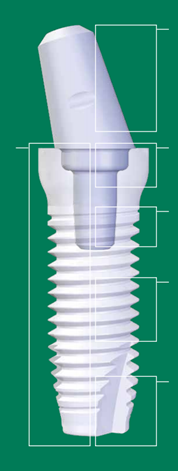Ceramic (Zirconia) Implant Technology
Austin, TX
What are ceramic implants?
 Ceramic implants are made from zirconium oxide. Similar to titanium (Ti), zirconium (Zr) is one of the few elements that is able to integrate to the jaw bone- a testament to both of their biologic compatibility. While zirconium is in the same transitional metal family as titanium, there are instances when zirconia implants are more ideal. Elemental zirconium is grey (like Ti) but dental ceramic zirconia is white in color, more similar to the natural root. At 98%, the success rates are at least equal to that of titanium implants. Ceramic implants are made from zirconium oxide. Similar to titanium (Ti), zirconium (Zr) is one of the few elements that is able to integrate to the jaw bone- a testament to both of their biologic compatibility. While zirconium is in the same transitional metal family as titanium, there are instances when zirconia implants are more ideal. Elemental zirconium is grey (like Ti) but dental ceramic zirconia is white in color, more similar to the natural root. At 98%, the success rates are at least equal to that of titanium implants.
What are the disadvantages of ceramic implants?
One of the concerns about zirconia is its poor fracture toughness. Most ceramic implants are press-manufactured. The implant system that we use uses a proprietary technique of Hot-Isotonic Pressing (HIPping). HIPping is done with temperatures of >1,200[-3920]C and pressures of >2000 Torr which allows the Zr molecules to be compacted and, thus, stronger. The element- Yttrium is used to stabilize the tetragonal polycrystalline structure because of the 35% shrinkage under HIPping.
Zirconia in the Industry
If the technology is here with over a decade of existing research at 98% success rates, why is zirconia not the industry standard?
 . Because of the difficulty in manufacturing Zirconia under proprietary HIPping, it is almost ten times more costly to manufacture zirconia implants compared to titanium. However, the total cost is comparable since no other components are needed (like a restorative or healing abutment) because of its one-piece design. Because all businesses are looking at profits, it does not make sense to invest in research and produce a costly implant. Profits are much greater with titanium implants. . Because of the difficulty in manufacturing Zirconia under proprietary HIPping, it is almost ten times more costly to manufacture zirconia implants compared to titanium. However, the total cost is comparable since no other components are needed (like a restorative or healing abutment) because of its one-piece design. Because all businesses are looking at profits, it does not make sense to invest in research and produce a costly implant. Profits are much greater with titanium implants.
Why are zirconia implants one-piece implants?
FDA approval was with one-piece Zr implants. Original pressed-zirconia have greater risk of fracture with the heavy chewing forces. This was minimized with the one-piece design. The newest generation of zirconia implants have much greater flexural strength and fracture toughness as compared to previous generations and are now equivalent to titanium implants. The one-piece design has some restorative limitations when compared to two-piece titanium implants (implant + abutment). The angulation of the implant must be perfect because of their one-piece nature. It is important that the ridge is preserved through bone grafting to prevent the 50% bone collapse (seen without grafting). Thus, the bone site for the implant must be ideal, which may also mean that immediate placement is not possible.
What are the advantages of ceramic implants?
There are numerous benefits to zirconia implants. The color of Zr implants is aesthetically pleasing. Gum tissues attach and are healthier around a Zr surface. The Zr surface repels bacteria which makes regular periodontal maintenance easier. It is galvanically neutral and will not block meridian flows. Most of all, Zr is biologically inert and non-reactive to heavy metals and fluoride.
What's new with ceramic (zirconia) implant technology?
Two-piece: One of the relative contraindications for a one-piece implant is when there is no adjacent teeth to protect from loading against a long zirconia implant abutment in the mouth. Now, Dr. Yu is certified to place a new FDA-cleared two-piece ceramic implant. A restorative abutment is torqued using a carbon fiber screw allowing for greater elastic properties for Zr implant. This makes two-piece Zr implants possible with increased fracture resistance. When bone is available, patients can receive a zirconia implant in almost every instance.
Surface Laser-Modified (SLM): Lasers are now used to roughen the surface of the zirconia implant. This increases the surface area of the implant by up to 100x. With the natural hydrophilic nature of zirconia, the body attaches to the surface and maintains it more readily.
Dr. David Yu is one of few surgeons in central Texas certified to place zirconia implants. Please call Periodontal Surgical Arts at 512-306-8822 for an evaluation and consultation to determine if you are a candidate for a zirconia implant. We are here to help and happy to address any questions you may have. |